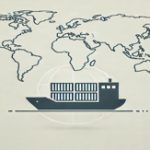The trade war between the United States and China has left a significant mark on global trade dynamics. Beginning in 2018, this economic conflict reshaped import-export flows, altered supply chains, and shifted geopolitical alliances. It wasn’t merely a clash of tariffs; it represented a broader struggle for economic dominance and technological leadership. This write-up delves into the history of the trade war, its roots, key moments, and the countries that gained a competitive edge. We will also explore the implications for businesses and consumers, analyze the positions of other major trading partners, and look ahead to what the future holds for global trade.

The History of the Trade War: Origins and Escalation
The US-China trade war officially began in 2018, but its origins can be traced back further. Tensions had simmered for years over China’s trade practices, intellectual property policies, and its rapid economic rise. The United States accused China of unfair trade practices, including forced technology transfers, intellectual property theft, and state subsidies that gave Chinese companies an unfair advantage. These issues were not new, but the administration under then-President Donald Trump took a more aggressive stance.
In March 2018, the United States imposed tariffs on imported steel and aluminum, citing national security concerns. This marked the first significant move in the trade war. Shortly afterward, the US targeted China directly with tariffs on $50 billion worth of Chinese goods, particularly focusing on technology-related imports. China retaliated with its own tariffs, targeting American agricultural products and automobiles. The tit-for-tat tariff exchange intensified over the next two years, with both sides imposing duties on hundreds of billions of dollars worth of goods. By 2019, the trade war had expanded to include issues like Chinese telecommunications giant Huawei, with the US imposing sanctions and banning its products over national security concerns.
The Roots of the Conflict: Why the Trade War Started
The underlying causes of the trade war go beyond mere economic grievances. At its core, the US-China trade conflict is a clash over global economic leadership and technological dominance. The United States, which has long been a leader in technological innovation, views China’s rapid advancements, particularly in fields like 5G and artificial intelligence, as a strategic threat. China, on the other hand, sees its rise as a rightful return to historical economic prominence.
Another key issue is the trade deficit. The US consistently ran a trade deficit with China, importing significantly more than it exported. For many American policymakers, this imbalance symbolized deeper issues, such as China’s control over critical supply chains and its trade practices that hindered foreign companies’ access to its markets. By imposing tariffs, the US aimed to reduce the deficit, bring back manufacturing jobs, and pressure China to adopt fairer trade practices.
Winners and Losers: Which Countries Gained an Edge?
The trade war reshuffled the global trading landscape, creating both winners and losers. While the US and China faced direct economic impacts, other countries found opportunities amidst the turmoil. Southeast Asian nations, such as Vietnam, Thailand, and Malaysia, experienced a surge in foreign investment as companies sought to diversify their supply chains away from China. Vietnam, in particular, became a manufacturing hub, benefiting from its proximity to China and its favorable trade agreements with the US and other countries.
Mexico also gained from the trade war as American companies looked closer to home for manufacturing alternatives. The implementation of the United States-Mexico-Canada Agreement (USMCA) further strengthened Mexico’s position as a key supplier to the US market. In Europe, countries like Germany and France experienced mixed effects. While they faced challenges due to reduced demand in China and the US, they also found opportunities in filling gaps left by tariffed American and Chinese goods.
However, some nations found themselves caught in the middle. Many developing economies in Africa and Latin America, which had grown dependent on Chinese investment and trade, faced uncertainty as China’s focus shifted inward. Similarly, Australia and Canada, major exporters of raw materials to China, faced disruptions in their trade relations.
Implications of the Trade War: Economic and Political Shifts
The trade war has had wide-ranging implications for global trade and economic stability. One of the most direct impacts has been the increase in costs for businesses and consumers. Tariffs led to higher prices on imported goods, affecting everything from electronics to agricultural products. American companies faced higher production costs, which they often passed on to consumers. In response, many US-based firms sought new suppliers outside China, adding complexity to their supply chains.
The trade war also highlighted the fragility of global supply chains, especially in critical industries like semiconductors and electronics. The COVID-19 pandemic further exposed these vulnerabilities, leading to a renewed focus on reshoring manufacturing and diversifying supply chains. Countries like the US and Japan have since implemented policies to reduce dependency on Chinese manufacturing, incentivizing companies to relocate production.
Politically, the trade war has deepened divisions between the US and China, accelerating a decoupling trend in their economies. This decoupling goes beyond tariffs; it includes restrictions on Chinese investments in American technology firms, visa bans on Chinese researchers, and efforts to build domestic alternatives to critical Chinese supply chains.
The Stance of Other Major Trade Partners: Navigating the Conflict
As the US and China locked horns, other major trading partners adopted different strategies to navigate the situation. The European Union, for instance, sought to maintain a balance. While it shares some of the US’s concerns about China’s trade practices, it has generally favored a more diplomatic approach, engaging China through dialogue and trade agreements, such as the Comprehensive Agreement on Investment (CAI). However, tensions between the EU and China have grown due to human rights issues and geopolitical concerns.
Japan and South Korea, two key American allies, faced the challenge of balancing their economic ties with China while supporting US-led initiatives to counter Chinese influence. Both countries have deep trade relationships with China, yet they have joined US-led efforts like the “Quad” partnership, which aims to counter China’s influence in the Indo-Pacific region.
India, meanwhile, positioned itself as a potential alternative to China for global manufacturing. It has capitalized on the shift in supply chains, attracting investment from companies seeking to reduce their reliance on Chinese production. India’s participation in initiatives like the Indo-Pacific Economic Framework highlights its strategic importance in the evolving global trade landscape.
The Future of Global Trade: What Lies Ahead?
Looking forward, the US-China trade war has set the stage for a new era of global trade characterized by competition and fragmentation. The initial “Phase One” trade deal between the US and China in early 2020, which required China to purchase additional American goods, has failed to resolve the deeper issues at play. While tariffs remain in place, both countries continue to pursue economic strategies that prioritize self-reliance and technological leadership.
The shift toward “friend-shoring” and regional trade agreements, where countries focus on securing supply chains with trusted allies, is likely to continue. This trend could reshape the global economy, leading to the emergence of distinct economic blocs centered around the US and China.
Yet, the future is not without opportunities for cooperation. Global challenges like climate change and pandemic recovery could compel the US and China to find common ground, potentially easing tensions in other areas. However, any rapprochement is likely to be limited and transactional, with underlying strategic competition persisting.
For businesses, the lessons of the trade war underscore the need for flexibility and adaptability. As tariffs and geopolitical risks reshape trade routes, companies must continue to explore new markets, diversify suppliers, and adapt to changing regulations. Those that can navigate the complexities of the new trade environment will find opportunities in a world of shifting alliances and emerging markets.
Conclusion
The US-China trade war has reshaped global trade in profound ways, altering import markets, disrupting supply chains, and challenging businesses to adapt. What began as a bilateral dispute has evolved into a global shift with economic and political ramifications that are still unfolding. While some countries have gained a competitive edge, others have struggled to adapt to the new reality. As the world moves forward, the focus will be on how countries balance competition with cooperation, and how businesses adapt to the complexities of a divided yet interconnected global economy. The trade war may have started with tariffs, but its effects will continue to shape global trade for years to come.
You can contact us on WhatsApp to discuss this topic further.
References
- Bown, C. P. (2021). The US-China Trade War and Phase One Agreement. The Peterson Institute for International Economics. Retrieved from https://www.piie.com/
- Morrison, W. M. (2019). China-US Trade Issues. Congressional Research Service. Retrieved from https://crsreports.congress.gov/
- The World Bank (2020). Impacts of the US-China Trade War on Global Trade Patterns. Retrieved from https://www.worldbank.org/
- European Union Chamber of Commerce in China (2021). Decoupling: Severed Supply Chains and the Risks for Businesses. Retrieved from https://www.europeanchamber.com.cn/
- United States Trade Representative (USTR) (2018). Findings of the Investigation into China’s Acts, Policies, and Practices Related to Technology Transfer, Intellectual Property, and Innovation. Retrieved from https://ustr.gov/
- The Economist (2023). After the Trade War: What’s Next for US-China Relations? Retrieved from https://www.economist.com/
- Cheng, L., & Meijerink, G. (2020). Vietnam and the US-China Trade War: A New Economic Reality. Asia-Pacific Economic Review. Retrieved from https://www.apec.org/
- Financial Times (2022). How Companies Are Adapting to the New Trade Reality. Retrieved from https://www.ft.com/




